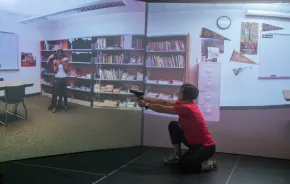
I’m a parent, English tutor and teacher. Over the years, my students, kids and I have enjoyed many, many wonderful graphic novels. Something I love about graphic novels is the breadth of diversity represented.
When I say “diversity,” I mean racial diversity, neurodiversity and diversity with respect to gender/sexuality expression represented by the characters and/or authors. This list is by no means an exhaustive or authoritative list; it is offered more as a starting point for your young readers.
These recommended reads are ordered roughly by the age of the reader, though with graphic novels, I often see kids reading a greater range of content and at higher reading levels, so I wouldn’t count out any of these titles unless the content doesn’t seem right for your reader.
‘Pilu of the Woods’ by Mai K. Nguyen
This lovely book about a girl, a dog and a forest spirit is my daughter’s favorite. She identifies with the character who has big, sometimes scary, feelings.
‘Mighty Jack’ by Ben Hatke
Everyone in my house — nay, everyone I know who has read it — has enjoyed this alien take on the Jack and the Beanstalk tale. I also appreciate the portrayal of Jack’s sister, who is a neurodivergent hero in this three-book series.
‘Nightlights’ by Lorena Alvarez
I will read anything by Alvarez, a Colombian illustrator and writer who creates whimsical, super-saturated artwork to complement topics related to mental health. This book is the first in a series and is short enough to read in one sitting. My kids have loved it since they were little, but note that some kids might find the magical elements a tad spooky.
‘Princess Princess Ever After’ by K. O’Neill
We have enjoyed several offerings by this author/illustrator, but “Princess,” a queer graphic novel, was a particular hit with my Disney-loving kid who appreciates adventure and female warriors who work together.
‘The Legend of Auntie Po’ by Shing Yin Khor
This National Book Award finalist reimagines the Paul Bunyan myth, recasting the legend with a Chinese woman. The story is told through Mei, a teenager working at a Sierra Nevada logging camp.
‘Guts’ by Raina Telgemeier
Telgemeier is a hitmaker with both my elementary-age and teenage readers. This autobiographical account of her childhood depicts the physical manifestations our worries can take in our bodies, and, unlike many other books, does so very realistically. This enjoyable read is a nice counterbalance to other stories in which anxieties are presented as metaphors.
‘The Baby-sitters Club’ series
Based on the novels by Ann M. Martin, variously adapted as a graphic novel series by Raina Telgemeier, Gale Galligan, Gabriella Epstein and Chan Chau
I love how different adapters have approached the different stories in the “Baby-sitters Club” canon. For younger readers, my daughter enjoyed the “Baby-sitters Little Sister” graphic novel series, adapted by Katy Farina. I haven’t had the heart — gulp! — to break the news to her yet that the Netflix series has been canceled. Besides being great, the film series created more diverse casting and stories than the original.
‘The Witch Boy’ by Molly Knox Ostertag
The New York Times described this book as having “natural-feeling diversity,” which struck me as odd phrasing, but it’s true. More than just a graphic novel about diverse characters, it’s a lovely coming-of-age story about finding your true self within the context of your own family.
‘Pashmina’ by Nidhi Chanani
I appreciated the author’s choice of when to use black and white versus color in this book. It’s a story about an Indian American girl whose mother refuses to talk about her life in India.
‘New Kid’ by Jerry Craft
My middle-school-age students in a predominantly white school read this book about a boy who is one of the few students of color in his new school. It does a nice job of addressing the conflict between one’s home and family culture and one’s school culture, and how those cultures can sometimes be at odds with who you are as a whole.
‘Snapdragon’ by Kat Leyh
Magic, generational story lines, teen friendship: This book has everything. There are some plot twists that I haven’t seen too often in YA graphic literature, and they sparked some important conversations in my house about love and friendship.
‘Persepolis: The Story of a Childhood’ by Marjane Satrapi
This graphic novel and movie adaptation have been around for as long as I’ve been teaching, and while it tells the story of a childhood, it is perhaps more suitable for teens, as it takes place during the Islamic Revolution in Iran.
Bonus Bundle: Best Graphic Novel Adaptations of Classics
As an English teacher and tutor, I have worked with some fantastic kids, not all of whom consider themselves “readers.” Some kids don’t enjoy reading; others may have processing disorders or neurodivergence; and some may speak English as a second language, or have other reasons for avoiding the written word. When reading a tome of classic literature might be difficult for a student, I recommend the graphic novel version when one is available. Here are five of my students’ favorites:
‘Anne of Green Gables’ by Lucy Maud Montgomery, adapted by Mariah Marsden and illustrated by Brenna Thummler
The gorgeous art in this graphic novel sucked in my early-elementary readers. Promises of more adventures from Anne and her friends in books and the various film and TV adaptations of Lucy Maud Montgomery’s classic children’s novels made this the perfect gateway to “Green Gables.”
‘A Wrinkle in Time’ by Madeleine L’Engle, adapted by Hope Larson
I didn’t know I needed a graphic adaptation of this middle-grade classic, but I’m thrilled it exists. Sometimes a graphic novel is not meant to replace a classic so much as to present a take on the world the author created. I enjoyed Larson’s visualizations of all the wondrous worlds in the novel.
‘Anne Frank’s Diary: The Graphic Adaptation’ by Anne Frank, adapted by Ari Folman and illustrated by David Polonsky
I can’t believe how these collaborators so gorgeously evoke Anne’s inner world in this graphic novel adaptation. I’ve read the original diary and play many times as a student and teacher, but only after reading the graphic adaptation with my students did I feel the beauty and pain of being a teenage girl hiding in an attic.
‘To Kill a Mockingbird’ by Harper Lee, adapted by Fred Fordham
I’m sorry to say it, but most kids hate reading “To Kill a Mockingbird.” It’s usually thrown into a curriculum to help ground a conversation about racism in the American South. Racism is actually a subplot in this coming-of-age novel about a young girl; there are much better offerings by Black writers to explore the history of racism in America. When students are assigned to read it in class and struggle through the truly soporific first chapter, I point them to the graphic novel, which moves at a clip and keeps all the most important plot points intact.
‘The Odyssey’ by Homer, adapted by Gareth Hinds
This is another classic that many students struggle with because of the heft of the original. With its gorgeous illustrations and clear, concise plotting, this adaptation is a fantastic starting point for introducing the original text.
Keep on reading |











